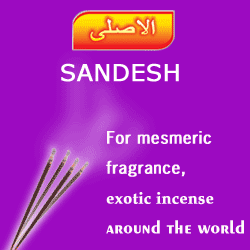|
|
| |
| Padma Perfumery Works Replenish your senses! |
| Rose Incense |
White Musk Incense |
Al Oudh Incense |
Sheik Al Arab Blue |
Jasmine Incense |
|
|
|
|
|
 |
 |
 |
 |
 |
|
|
|
Cassia Incense
 Cassia incense and Cassia incense sticks are made from bark or wood of the cassia tree. The cassia tree is an evergreen tree native to tropical Asia. Also called "the tree of golden shower", the botanical name of this ornamental plant is Cassia fistula L and it belongs to the family of fabaceae. Its importance lies in its aromatic bark, which is used as a spice and for many medicinal purposes. In ancient Sanskrit this flowering tree is called aragvadha, which means "disease killer" and is used extensively in Ayurveda. Cassia is closely related to Ceylon Cinnamon but it less delicate flavor and hence is less expensive. The bark is also thicker, coarser, darker as compared to that of cinnamon.
Cassia incense and Cassia incense sticks are made from bark or wood of the cassia tree. The cassia tree is an evergreen tree native to tropical Asia. Also called "the tree of golden shower", the botanical name of this ornamental plant is Cassia fistula L and it belongs to the family of fabaceae. Its importance lies in its aromatic bark, which is used as a spice and for many medicinal purposes. In ancient Sanskrit this flowering tree is called aragvadha, which means "disease killer" and is used extensively in Ayurveda. Cassia is closely related to Ceylon Cinnamon but it less delicate flavor and hence is less expensive. The bark is also thicker, coarser, darker as compared to that of cinnamon.
The cassia tree appears as a middle sized tree, generally 15-20 meters tall and has a grayish bark with long stretched leaves, about 20-60 cm long. The leaves are evergreen in nature and has a very pleasant flame red shade when young. This fast grower is deciduous in nature and the fruit that the female plant bears resembles small cloves and it is extensively used in confectionery and in making potpourri. Although the cassia tree prefers a moist and well drained soil type, it is almost tolerant of most soils and can flourish in almost every normal ecosystem.
By the age of ten or twelve cassia trees are at their greatest perfection and is ready to be harvested. The best and the most pungent barks come from the young shoots or from trees which are grown in rocky terrains. The bark should separate easily from the wood, and be covered inside with a mucilaginous juice to retain the richness in the flavor of the spice. The barks are then dried in the sun and exported in bundles of about 12 inches long.
Chemical Constituents
- Cinnamic aldehyde
- Cinnamyl acetate
- Cinnamic acid
- Phenylpropyl acetate
- Orthocumaric aldehyde
- Tannic acid
- Starch.
Biological Profile
- Kingdom : Plantae
- Classification : Angiosperms, Magnoliids
- Order : Laurales
- Family : Lauraceae
- Genus : Cinnamomum
- Species : C. aromaticum
Medical Uses
- The bark of cassia is a known stomachic and helps in toning the stomach by stimulating digestion, increasing appetite and thereby improving its function.
- It is also known to have carminative properties and is prescribed to prevent formation of gas in the gastrointestinal tract.
- An an emmenagogue, it helps stimulate the flow of blood in the pelvic area and the uterus and has the potential to provoke mensuration.
- The alcoholic extract from the cassia tree is used against uterine hemorrhage and menorrhagia and is also used as a flavor to assist other drugs prescribed to treat diarrhoea, nausea and vomiting.
- Cassia oil is a strong germicide.
Due to their various properties as listed above and the pleasant fragrance the cassia incense, cassia incense sticks and other cassia incense products are very popular in the world. Feel free to contact us to buy or for more information on cassia incense, cassia incense sticks and other cassian incense products.
|
|
|









 Cassia incense and Cassia incense sticks are made from bark or wood of the cassia tree. The cassia tree is an evergreen tree native to tropical Asia. Also called "the tree of golden shower", the botanical name of this ornamental plant is Cassia fistula L and it belongs to the family of fabaceae. Its importance lies in its aromatic bark, which is used as a spice and for many medicinal purposes. In ancient Sanskrit this flowering tree is called aragvadha, which means "disease killer" and is used extensively in Ayurveda. Cassia is closely related to Ceylon Cinnamon but it less delicate flavor and hence is less expensive. The bark is also thicker, coarser, darker as compared to that of cinnamon.
Cassia incense and Cassia incense sticks are made from bark or wood of the cassia tree. The cassia tree is an evergreen tree native to tropical Asia. Also called "the tree of golden shower", the botanical name of this ornamental plant is Cassia fistula L and it belongs to the family of fabaceae. Its importance lies in its aromatic bark, which is used as a spice and for many medicinal purposes. In ancient Sanskrit this flowering tree is called aragvadha, which means "disease killer" and is used extensively in Ayurveda. Cassia is closely related to Ceylon Cinnamon but it less delicate flavor and hence is less expensive. The bark is also thicker, coarser, darker as compared to that of cinnamon. 